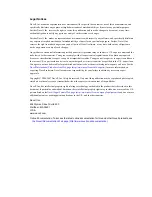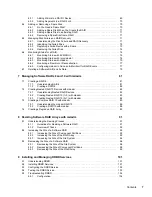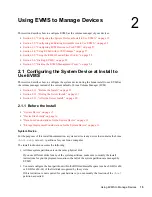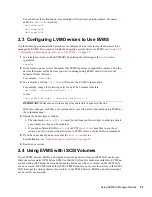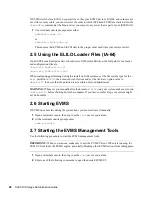
16
SLES 10 Storage Administration Guide
no
vd
ocx
(e
n)
6 Ap
ril 20
07
Your system uses the Grub or LILO boot loaders.
If you have an IA64 system, you must modify these install instructions to use the ELILO boot
loader (
/boot/efi/elilo.conf
) instead.
WARNING:
Whenever you manually alter the kernel or
initrd
on your system, make sure
to run
/sbin/elilo
before shutting down the computer. If you leave out this step, your
system might not be bootable.
Device Size Limits
Version 2.3 and later of
mdadm
supports component devices up to 4 TB in size each. Earlier
versions support component devices up to 2 TB in size.
IMPORTANT:
If you have a local disk, external disk arrays, or SAN devices that are larger than the
supported device size, use a third-party disk partitioner to carve the devices into smaller logical
devices.
You can combine up to 28 component devices to create the RAID array. The
md
RAID device you
create can be up to the maximum device size supported by the file system you plan to use. For
information about file system limits for SUSE
®
Linux Enterprise Server 10, see “Large File System
Support” in the
SUSE Linux Enterprise Server 10 Installation and Administration Guide.
(http://
www.novell.com/documentation/sles10)
.
Data Loss Considerations for the System Device
This install requires that you delete the default partitioning settings created by the install, and create
new partitions to use EVMS instead. This destroys all data on the disk.
WARNING:
To avoid data loss, it is best to use the EVMS install option only on a new device.
If you have data volumes on the system device, take one or more of the following precautionary
measures:
Move the data volumes from the system device to another device.
If you cannot move the volumes, make a backup copy of the data, so you can restore the data
volumes later from a backup copy.
Storage Deployment Considerations for the System Device
By default, the YaST install for SUSE Linux Enterprise Server uses the Linux Volume Manager to
manage the system device. The install procedures in this section describe how to install SUSE Linux
Enterprise Server with EVMS as the volume manager of the system device. The instructions assume
the following:
You want to use EVMS to manage the system device.
Only the system device is to be configured during the install.
Other devices on the system are not configured during the install, or are attached to the server
later. These additional devices are configured only after the system is operating and performing
as expected.
Summary of Contents for LINUX ENTERPRISE SERVER 10 - STORAGE ADMINISTRATION GUIDE 7-2007
Page 4: ...novdocx en 6 April 2007...
Page 30: ...30 SLES 10 Storage Administration Guide novdocx en 6 April 2007...
Page 42: ...42 SLES 10 Storage Administration Guide novdocx en 6 April 2007...
Page 58: ...58 SLES 10 Storage Administration Guide novdocx en 6 April 2007...
Page 90: ...90 SLES 10 Storage Administration Guide novdocx en 6 April 2007...
Page 100: ...100 SLES 10 Storage Administration Guide novdocx en 6 April 2007...
Page 106: ...106 SLES 10 Storage Administration Guide novdocx en 6 April 2007...

